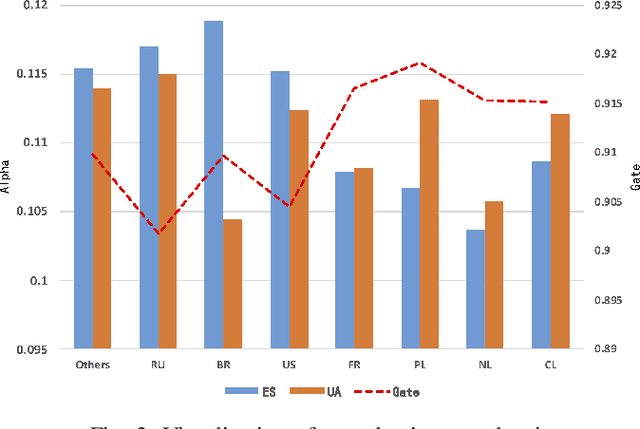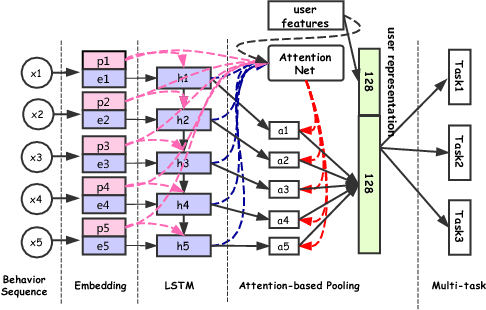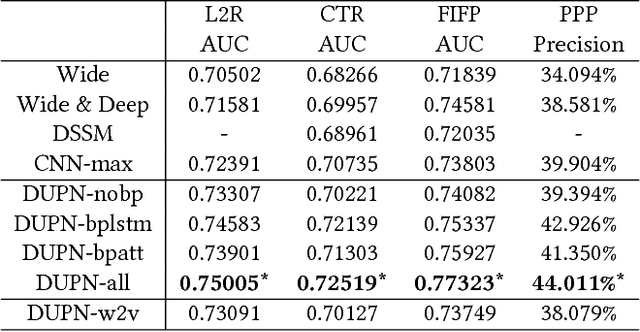Yabo Ni
Reveal Hidden Pitfalls and Navigate Next Generation of Vector Similarity Search from Task-Centric Views
Dec 15, 2025Abstract:Vector Similarity Search (VSS) in high-dimensional spaces is rapidly emerging as core functionality in next-generation database systems for numerous data-intensive services -- from embedding lookups in large language models (LLMs), to semantic information retrieval and recommendation engines. Current benchmarks, however, evaluate VSS primarily on the recall-latency trade-off against a ground truth defined solely by distance metrics, neglecting how retrieval quality ultimately impacts downstream tasks. This disconnect can mislead both academic research and industrial practice. We present Iceberg, a holistic benchmark suite for end-to-end evaluation of VSS methods in realistic application contexts. From a task-centric view, Iceberg uncovers the Information Loss Funnel, which identifies three principal sources of end-to-end performance degradation: (1) Embedding Loss during feature extraction; (2) Metric Misuse, where distances poorly reflect task relevance; (3) Data Distribution Sensitivity, highlighting index robustness across skews and modalities. For a more comprehensive assessment, Iceberg spans eight diverse datasets across key domains such as image classification, face recognition, text retrieval, and recommendation systems. Each dataset, ranging from 1M to 100M vectors, includes rich, task-specific labels and evaluation metrics, enabling assessment of retrieval algorithms within the full application pipeline rather than in isolation. Iceberg benchmarks 13 state-of-the-art VSS methods and re-ranks them based on application-level metrics, revealing substantial deviations from traditional rankings derived purely from recall-latency evaluations. Building on these insights, we define a set of task-centric meta-features and derive an interpretable decision tree to guide practitioners in selecting and tuning VSS methods for their specific workloads.
Embed Progressive Implicit Preference in Unified Space for Deep Collaborative Filtering
May 28, 2025Abstract:Embedding-based collaborative filtering, often coupled with nearest neighbor search, is widely deployed in large-scale recommender systems for personalized content selection. Modern systems leverage multiple implicit feedback signals (e.g., clicks, add to cart, purchases) to model user preferences comprehensively. However, prevailing approaches adopt a feedback-wise modeling paradigm, which (1) fails to capture the structured progression of user engagement entailed among different feedback and (2) embeds feedback-specific information into disjoint spaces, making representations incommensurable, increasing system complexity, and leading to suboptimal retrieval performance. A promising alternative is Ordinal Logistic Regression (OLR), which explicitly models discrete ordered relations. However, existing OLR-based recommendation models mainly focus on explicit feedback (e.g., movie ratings) and struggle with implicit, correlated feedback, where ordering is vague and non-linear. Moreover, standard OLR lacks flexibility in handling feedback-dependent covariates, resulting in suboptimal performance in real-world systems. To address these limitations, we propose Generalized Neural Ordinal Logistic Regression (GNOLR), which encodes multiple feature-feedback dependencies into a unified, structured embedding space and enforces feedback-specific dependency learning through a nested optimization framework. Thus, GNOLR enhances predictive accuracy, captures the progression of user engagement, and simplifies the retrieval process. We establish a theoretical comparison with existing paradigms, demonstrating how GNOLR avoids disjoint spaces while maintaining effectiveness. Extensive experiments on ten real-world datasets show that GNOLR significantly outperforms state-of-the-art methods in efficiency and adaptability.
Stitching Inner Product and Euclidean Metrics for Topology-aware Maximum Inner Product Search
Apr 21, 2025Abstract:Maximum Inner Product Search (MIPS) is a fundamental challenge in machine learning and information retrieval, particularly in high-dimensional data applications. Existing approaches to MIPS either rely solely on Inner Product (IP) similarity, which faces issues with local optima and redundant computations, or reduce the MIPS problem to the Nearest Neighbor Search under the Euclidean metric via space projection, leading to topology destruction and information loss. Despite the divergence of the two paradigms, we argue that there is no inherent binary opposition between IP and Euclidean metrics. By stitching IP and Euclidean in the design of indexing and search algorithms, we can significantly enhance MIPS performance. Specifically, this paper explores the theoretical and empirical connections between these two metrics from the MIPS perspective. Our investigation, grounded in graph-based search, reveals that different indexing and search strategies offer distinct advantages for MIPS, depending on the underlying data topology. Building on these insights, we introduce a novel graph-based index called Metric-Amphibious Graph (MAG) and a corresponding search algorithm, Adaptive Navigation with Metric Switch (ANMS). To facilitate parameter tuning for optimal performance, we identify three statistical indicators that capture essential data topology properties and correlate strongly with parameter tuning. Extensive experiments on 12 real-world datasets demonstrate that MAG outperforms existing state-of-the-art methods, achieving up to 4x search speedup while maintaining adaptability and scalability.
Clustered Embedding Learning for Recommender Systems
Feb 10, 2023Abstract:In recent years, recommender systems have advanced rapidly, where embedding learning for users and items plays a critical role. A standard method learns a unique embedding vector for each user and item. However, such a method has two important limitations in real-world applications: 1) it is hard to learn embeddings that generalize well for users and items with rare interactions on their own; and 2) it may incur unbearably high memory costs when the number of users and items scales up. Existing approaches either can only address one of the limitations or have flawed overall performances. In this paper, we propose Clustered Embedding Learning (CEL) as an integrated solution to these two problems. CEL is a plug-and-play embedding learning framework that can be combined with any differentiable feature interaction model. It is capable of achieving improved performance, especially for cold users and items, with reduced memory cost. CEL enables automatic and dynamic clustering of users and items in a top-down fashion, where clustered entities jointly learn a shared embedding. The accelerated version of CEL has an optimal time complexity, which supports efficient online updates. Theoretically, we prove the identifiability and the existence of a unique optimal number of clusters for CEL in the context of nonnegative matrix factorization. Empirically, we validate the effectiveness of CEL on three public datasets and one business dataset, showing its consistently superior performance against current state-of-the-art methods. In particular, when incorporating CEL into the business model, it brings an improvement of $+0.6\%$ in AUC, which translates into a significant revenue gain; meanwhile, the size of the embedding table gets $2650$ times smaller.
Scenario-aware and Mutual-based approach for Multi-scenario Recommendation in E-Commerce
Dec 16, 2020



Abstract:Recommender systems (RSs) are essential for e-commerce platforms to help meet the enormous needs of users. How to capture user interests and make accurate recommendations for users in heterogeneous e-commerce scenarios is still a continuous research topic. However, most existing studies overlook the intrinsic association of the scenarios: the log data collected from platforms can be naturally divided into different scenarios (e.g., country, city, culture). We observed that the scenarios are heterogeneous because of the huge differences among them. Therefore, a unified model is difficult to effectively capture complex correlations (e.g., differences and similarities) between multiple scenarios thus seriously reducing the accuracy of recommendation results. In this paper, we target the problem of multi-scenario recommendation in e-commerce, and propose a novel recommendation model named Scenario-aware Mutual Learning (SAML) that leverages the differences and similarities between multiple scenarios. We first introduce scenario-aware feature representation, which transforms the embedding and attention modules to map the features into both global and scenario-specific subspace in parallel. Then we introduce an auxiliary network to model the shared knowledge across all scenarios, and use a multi-branch network to model differences among specific scenarios. Finally, we employ a novel mutual unit to adaptively learn the similarity between various scenarios and incorporate it into multi-branch network. We conduct extensive experiments on both public and industrial datasets, empirical results show that SAML consistently and significantly outperforms state-of-the-art methods.
Perceive Your Users in Depth: Learning Universal User Representations from Multiple E-commerce Tasks
May 28, 2018



Abstract:Tasks such as search and recommendation have become increas- ingly important for E-commerce to deal with the information over- load problem. To meet the diverse needs of di erent users, person- alization plays an important role. In many large portals such as Taobao and Amazon, there are a bunch of di erent types of search and recommendation tasks operating simultaneously for person- alization. However, most of current techniques address each task separately. This is suboptimal as no information about users shared across di erent tasks. In this work, we propose to learn universal user representations across multiple tasks for more e ective personalization. In partic- ular, user behavior sequences (e.g., click, bookmark or purchase of products) are modeled by LSTM and attention mechanism by integrating all the corresponding content, behavior and temporal information. User representations are shared and learned in an end-to-end setting across multiple tasks. Bene ting from better information utilization of multiple tasks, the user representations are more e ective to re ect their interests and are more general to be transferred to new tasks. We refer this work as Deep User Perception Network (DUPN) and conduct an extensive set of o ine and online experiments. Across all tested ve di erent tasks, our DUPN consistently achieves better results by giving more e ective user representations. Moreover, we deploy DUPN in large scale operational tasks in Taobao. Detailed implementations, e.g., incre- mental model updating, are also provided to address the practical issues for the real world applications.
 Add to Chrome
Add to Chrome Add to Firefox
Add to Firefox Add to Edge
Add to Edge